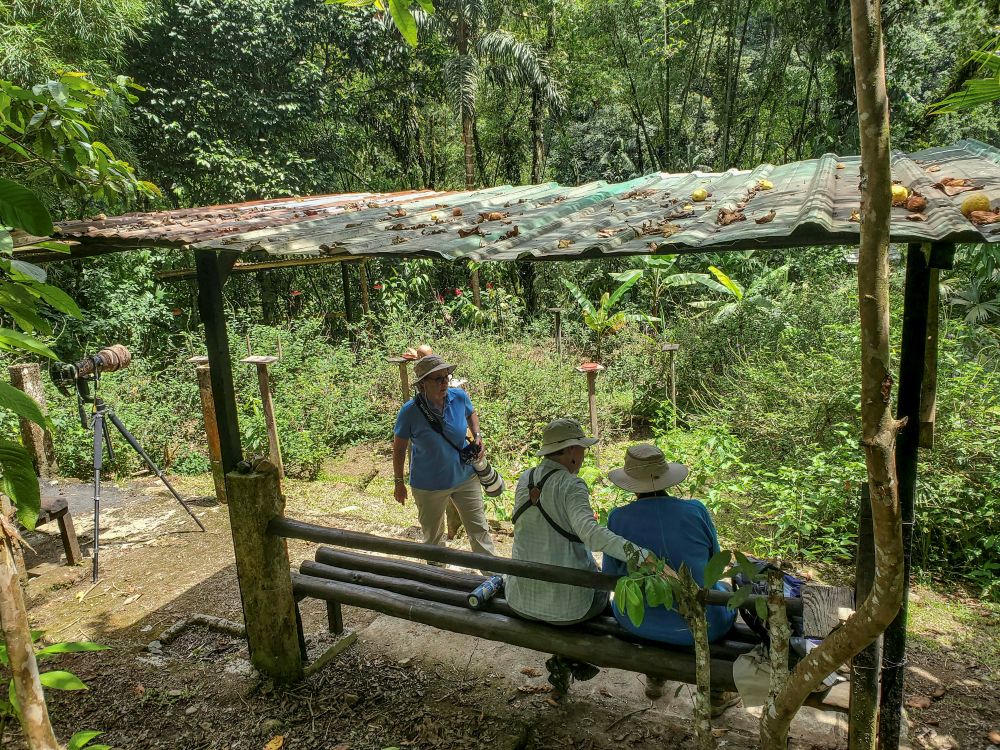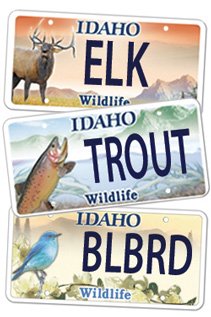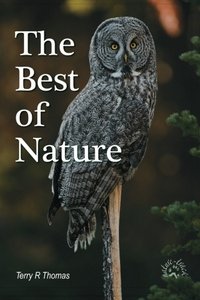Ecotourism

Bird feeding stations like this one help Ecuadorians add to and diversify their incomes, creating a side benefit of educating the people as to the positive aspects of conservation.
In many third-world and developing countries, wildlife and nature are often viewed as impediments to progress or at best, the means for survival. For many indigenous people, surviving day to day is the goal, and looking beyond that mark doesn’t even enter into their thinking. If killing and eating an endangered animal gets their family through another day, they won’t even question that decision. If cutting down part of a virgin rainforest will feed the family for several months, there is no decision to be made. This makes it difficult or impossible to “sell” conservation to these people.
In order to further the cause of conservation in developing areas, the people need to be shown how conservation can actually serve them. We saw this in action over three weeks we recently spent birding and photographing in Ecuador. Ecuador is a relatively poor country, where $35/day is considered a decent salary for a city dweller. Many of the more rural families subsist on far less than that. It is a tough life and getting by is the best most can hope for. Enter ecotourism.
Ecotourism is defined as, “responsible travel to natural areas that conserves the environment, sustains the well-being of the local people, and involves interpretation and education” (The International Ecotourism Society, 2015). Education is meant to be inclusive of both staff and guests and that is where it gets interesting.
Involving the local people shows them that conservation and personal economic growth can be compatible. Costa Rica has gone all in on this approach. According to the World Atlas, “The tourism industry has experienced the fastest growth in the country, and in 1995 it had become the country’s biggest earner of foreign exchange. As of 1999, earnings from tourism overtook the revenues from exports of the top three most important crops, which include coffee, pineapples, and bananas.”
Ecuador is considered one of the top ten most biodiverse countries on the planet (Brazil is first), but based on size (species per square kilometer) is often ranked second. There are still many intact forests protected within national parks and with over 1,650 bird species they surpass all of North America where there are just over 1,000 species. Simply put, Ecuador has a lot to share with the world.
Ecotourism, while not up to what Costa Rica is doing, is a growing business in Ecuador. There are dozens of lodges scattered from the Galapagos to the upper Amazon River basin that serve ecologically minded travelers on many levels. On our tour, we stayed in six different locations from the west side of the Andes Mountains to a native village on the Napo River, one of two main forks of the Amazon River.
At each place, native Ecuadorians served as staff, guides, and drivers, gained directly from our stay. We also visited at least a dozen private homes and small businesses (they call them, appropriately, reserves, and we saw many more than we visited) where the residents provided bird feeders to attract the birds. Our tour guide would make arrangements with them and pay them a fee for access. What was surprising was that these people were EXPERTS about the birds coming to their feeders. They could quickly identify them, knew their habits and could often predict behaviors. Despite their humble circumstances, they had become educated about the birds and had developed a love for them and consequently, were committed to conservation.
The native village we stayed at had also made a commitment to conservation with the help of several groups such as World Wildlife Fund. They had constructed guest housing and a kitchen and dining area that reflect their lifestyle. They guided us on tours through the rainforest and by canoe up jungle streams. We had a blast and they earned an income far better than selling fruit in the market.
This is what ecotourism is really all about—finding ways to get the local people to “buy in” to conservation and to recognize that their lives and the lives of the wild things around them can be mutually compatible.
Help Idaho Wildlife
When we traveled across the state in October 2017, we visited most of the Idaho Department of Fish and Game wildlife management areas. Most of the vehicles we saw using the wildlife management areas did not have wildlife plates. Buying wildlife plates is a great way for non-hunters and hunters alike to support wildlife-based recreation like birding.
C'mon folks, let's help Idaho's wildlife by proudly buying and displaying a wildlife license plate on each of our vehicles!
See below for information on Idaho plates. Most states have wildlife plates so if you live outside Idaho, check with your state's wildlife department or vehicle licensing division for availability of state wildlife plates where you live.
And tell them that you heard about it from Nature-track.com!

Wildlife License Plates
Great news! as of 2024, there are three NEW designs for license plates. They still are bluebird, cutthroat trout and elk, but they are beautiful.
Idaho Wildlife license plates provide essential funding that benefits the great diversity of native plants and wildlife that are not hunted, fished or trapped—over 10,000 species or 98% of Idaho’s species diversity. Game species that share the same habitats (such as elk, deer, antelope, sage-grouse, salmon, trout) also benefit from these specialty plates.
No state tax dollars are provided for wildlife diversity, conservation education and recreation programs. Neither are any revenues from the sale of hunting or fishing licenses spent on nongame species. Instead, these species depend on direct donations, federal grants, fundraising initiatives—and the Idaho Wildlife license plates.
Both my vehicles have Bluebird Plates. I prefer the bluebird because the nongame program gets 70 percent of the money from bluebird plates, but only 60 percent of the money from elk and trout plates - 10 percent of the money from elk plates supports wildlife disease monitoring and testing programs (to benefit the livestock industry) and 10 percent from cutthroat plates supports non-motorized boat access.
Incidentally, in 2014, the Idaho Legislature denied the Department of Fish and Game the ability to add new plates or even to change the name of the elk and cutthroat plates (very specific) to wildlife and fish plates, a move that would have allowed for changing images occasionally and generating more revenue. It would seem that they believe that we Idahoans don't want a well funded wildlife program.
I think it is time we let the Legislature know that Idahoan support wildlife funding and that we would like to see these generic plates come to fruition.

"WOW. What a phenomenal piece you wrote. You are amazing." Jennifer Jackson
That is embarrassing, but actually a fairly typical response to my nature essays. Since The Best of Nature is created from the very best of 16 years of these nature essays published weekly in the Idaho Falls Post Register (online readership 70,000), it is a fine read. It covers a wide variety of topics including humorous glimpses of nature, philosophy, natural history, and conservation. Readers praise the style, breadth of subject matter and my ability to communicate complex and emotional topics in a relaxed and understandable manner.
Everyone can find something to love in this book. From teenagers to octogenarians, from the coffee shop to the school room, these nature essays are widely read and enjoyed.
Some of the essays here are my personal favorites, others seemed to strike a chord with readers. Most have an important message or lesson that will resonate with you. They are written with a goal to simultaneously entertain and educate about the wonderful workings of nature. Some will make you laugh out loud and others will bring a tear to the eye and warm your heart.
Readers Write:
"You hit a home run with your article on, Big Questions in Nature. It should be required reading for everyone who has lost touch with nature...great job!" Joe Chapman
"We enjoyed your column, Bloom Where Planted. Some of the best writing yet. The Post Register is fortunate to have your weekly columns." Lou Griffin.
To read more and to order a copy, click here or get the Kindle version
Copies are also available at:
Post Register
Island Park Builders Supply (upstairs)
Barnes and Noble in Idaho Falls
Harriman State Park, Island Park
Museum of Idaho
Valley Books, Jackson Wyoming
Avocet Corner Bookstore, Bear River National Wildlife Refuge, Brigham City, Utah
Craters of the Moon National Monument Bookstore, Arco, Idaho